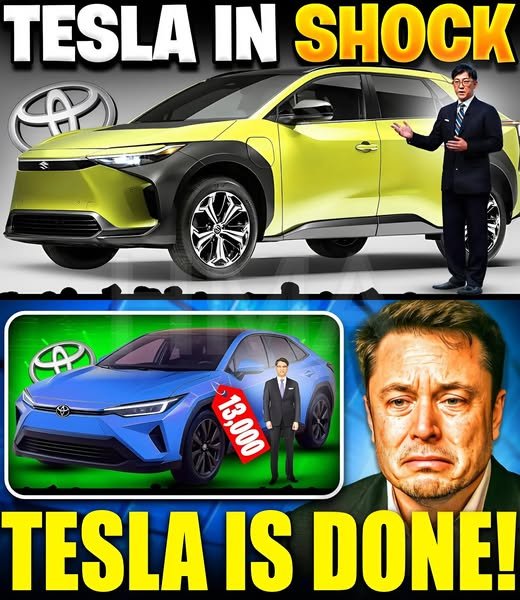Toyota Just Revealed New $13,000 EV & Challenges Tesla Model Y in China
Toyota has sent shockwaves through the electric vehicle (
EV) industry with the unveiling of its new bZ3X, a compact electric SUV priced at an astonishing 100,000 yuan (approximately $13,800 USD) in China. Launched in late 2024, the bZ3X has sparked intense discussion, with some claiming it could “destroy” the Tesla Model Y, the world’s best-selling EV. While the bZ3X’s affordability and competitive specs make it a formidable contender in China, its impact on Tesla’s dominance and its potential for global markets, particularly the U.S., warrant a closer look. This article explores the bZ3X’s features, its comparison to the Tesla Model Y, and the challenges it faces in reshaping the EV landscape.
The Toyota bZ3X: A Game-Changer in Affordability
The Toyota bZ3X, roughly the size of a RAV4, is designed to compete in the compact electric SUV segment. Built in collaboration with Guangzhou Automobile Group (GAC), a Chinese automaker known for cost-efficient EV production, the bZ3X leverages lithium iron phosphate (LFP) batteries, which are cheaper and require less maintenance than the lithium-ion batteries used in many EVs, including the Tesla Model Y. This strategic choice allows Toyota to offer the bZ3X at a starting price of $13,800, with higher trims reaching up to 200,000 yuan ($27,500).
The bZ3X is available in three trims: 430 Air+, 520 Pro+, and 620 Max. The entry-level 430 Air+ features a single electric motor producing 150 kW (201 horsepower) and a 50-kWh LFP battery, delivering a range of 267 miles (430 km) under China’s lenient CLTC testing cycle. Higher trims, such as the 620 Max, boast a 65-kWh battery and a claimed range of 385 miles (620 km), though real-world ranges are likely closer to 200-300 miles under EPA standards. The bZ3X supports fast charging, achieving a 10-80% charge in approximately 30 minutes, comparable to the Tesla Model Y’s 250 kW charging capability.
Styling-wise, the bZ3X borrows cues from Toyota’s Prius and Crown hybrids, featuring an aggressive nose, LED headlights, and a sporty, sloping roofline. Its interior includes a 12.8-inch touchscreen, wireless Apple CarPlay and Android Auto, and advanced driver-assistance systems (ADAS), positioning it as a tech-savvy option for urban buyers. With a boot capacity of approximately 1,800 liters (including the frunk), the bZ3X offers practicality for families, though it lacks the optional third-row seating available in some Model Y configurations.
Tesla Model Y: The Benchmark to Beat
The
Tesla Model Y, refreshed for 2025 under the “Juniper” codename, remains the gold standard in the electric
SUV market. Priced at $44,990 for the Rear-Wheel Drive (RWD) trim and $50,630 for the Long Range All-Wheel Drive (AWD) in the U.S. (before a $7,500 federal tax credit), the Model Y is significantly more expensive than the bZ3X. The Long Range AWD offers an EPA-estimated range of 327 miles, a 0-60 mph time of 4.1 seconds, and access to Tesla’s Supercharger network, which remains a benchmark for reliability and speed.
The 2025 Model Y introduces a sleeker front fascia, a full-width light bar, and enhanced interior features, including a 15.4-inch center touchscreen, an 8-inch rear touchscreen, ventilated front seats, and a 15-speaker sound system. Its Full Self-Driving (Supervised) system, a $8,000 option, provides advanced autonomous capabilities, though it requires driver supervision. With a boot capacity of 2,138 liters and optional seven-seat configuration, the Model Y excels in versatility. Its efficiency, at 13.6 kWh/100 km, outperforms many competitors, including the BYD Seal sedan.
Tesla’s global dominance is undeniable, with 1.2 million Model Ys delivered in 2023, making it the world’s best-selling vehicle that year, and an estimated 2.16 million units sold by December 2023. Despite a reported 44.4% year-over-year sales drop in Norway in early 2025, Tesla claims the Model Y was again the global best-seller in 2024. However, its higher price point and recent controversies surrounding CEO Elon Musk have prompted some buyers to explore alternatives like the bZ3X.
Head-to-Head: bZ3X vs. Model Y
Price and Affordability
The bZ3X’s starting price of $13,800 in China is a fraction of the Model Y’s $44,990 base price in the U.S. Even accounting for China’s EV subsidies and lower production costs, the bZ3X’s pricing is disruptive. However, U.S. pricing for the bZ3X, if it were to launch, is estimated at $37,500-$45,500 due to tariffs and regulatory costs, narrowing the gap with the Model Y. Current 25% U.S. tariffs on Chinese-made vehicles, potentially increasing under new trade policies, would further elevate the bZ3X’s price, making it less competitive stateside.
Performance and Range
The Model Y’s dual-motor AWD configuration delivers superior acceleration (4.1 seconds to 60 mph) compared to the bZ3X’s single-motor setup, which likely takes over 7 seconds. The Model Y’s 327-mile EPA range is more reliable than the bZ3X’s CLTC-based 267-385 miles, which may translate to 200-300 miles under stricter EPA testing. Both vehicles offer comparable fast-charging speeds, but Tesla’s Supercharger network provides a significant advantage in infrastructure reliability.
Technology and Features
The Model Y’s tech suite, including its advanced Autopilot and Full Self-Driving options, outpaces the bZ3X’s ADAS, which lacks semi-autonomous highway driving capabilities. The Model Y’s over-the-air updates and seamless software integration are industry-leading, while the bZ3X’s infotainment, though modern, is less sophisticated. However, the bZ3X’s lower price makes its tech offerings compelling for budget-conscious buyers.
Practicality
The Model Y’s larger boot (2,138 liters vs. 1,800 liters) and optional seven-seat configuration give it an edge for families. The bZ3X, designed for urban commuting, is slightly smaller but still practical, with a competitive cargo capacity. Its LFP battery offers durability and lower maintenance costs, appealing to cost-sensitive markets.
Market Impact and Challenges
China: A Direct Threat to Tesla
In China, the bZ3X’s low price and Toyota’s brand reliability pose a significant challenge to the Model Y, which starts at a higher price point (approximately $40,000 USD equivalent). Toyota’s collaboration with GAC allows it to leverage local manufacturing and government subsidies, enabling aggressive pricing. Posts on X have hyped the bZ3X as a “Tesla killer,” with claims like “Elon Musk LOSES IT” reflecting the sentiment among some EV enthusiasts. However, these claims are inconclusive and exaggerated, as Tesla’s established infrastructure and brand loyalty remain strong. The bZ3X’s reported 70,000 orders in its first five days in China signal robust demand, but Tesla’s Model Y continues to lead in sales volume.
U.S. and Global Markets: A Distant Prospect
The bZ3X is currently exclusive to China, with no confirmed plans for a U.S. launch. U.S. tariffs, which increased to 25% on Chinese-made vehicles in 2025, would inflate the bZ3X’s price to near Model Y levels, diminishing its affordability advantage. For example, the Toyota bZ4X, available in the U.S. starting at $37,070, is significantly more expensive than the bZ3X’s Chinese price due to import costs and market positioning. Regulatory hurdles, such as U.S. safety and emissions standards, would further complicate a bZ3X launch. In contrast, the Model Y benefits from domestic production at Tesla’s Fremont and Texas factories, qualifying it for the $7,500 federal tax credit.
Toyota’s cautious approach to EVs in the U.S., where it prioritizes hybrids like the Prius and Camry, suggests the bZ3X may remain a China-specific model. Meanwhile, Tesla is countering with plans for a “decontented” Model Y variant priced around $35,000 in Mexico, aimed at budget-conscious buyers, though its U.S. launch has been delayed to 2026.
Toyota’s Strategy: Loss Leader or Long-Term Play?
Reports indicate Toyota may be selling the bZ3X at a loss to capture market share and accelerate EV adoption, a strategy similar to BYD’s aggressive pricing. By using LFP batteries and leveraging GAC’s manufacturing expertise, Toyota minimizes costs while building brand presence in China’s competitive EV market. This approach contrasts with Tesla’s focus on profitability, though Tesla’s gross margins have tightened due to price cuts in 2023 and 2024. Toyota’s long-term goal appears to be establishing a foothold in EVs, potentially paving the way for higher-margin models like the C-HR+, a stylish electric SUV set for Europe in 2026.
Fan and Industry Reactions
The bZ3X’s launch has generated buzz on X, with posts claiming it “obliterates” the Model Y and could “change the industry forever.” These sentiments, while enthusiastic, overstate the bZ3X’s immediate impact, as Tesla’s global sales and infrastructure remain unmatched. Industry analysts are more measured, noting that the bZ3X’s success in China is significant but its global influence depends on overcoming trade barriers and scaling production. One X user wrote, “Toyota’s $13,000 EV is a wake-up call for Tesla,” reflecting the competitive pressure, while another cautioned, “It’s China-only for now. Let’s see if it ever hits the U.S.”



